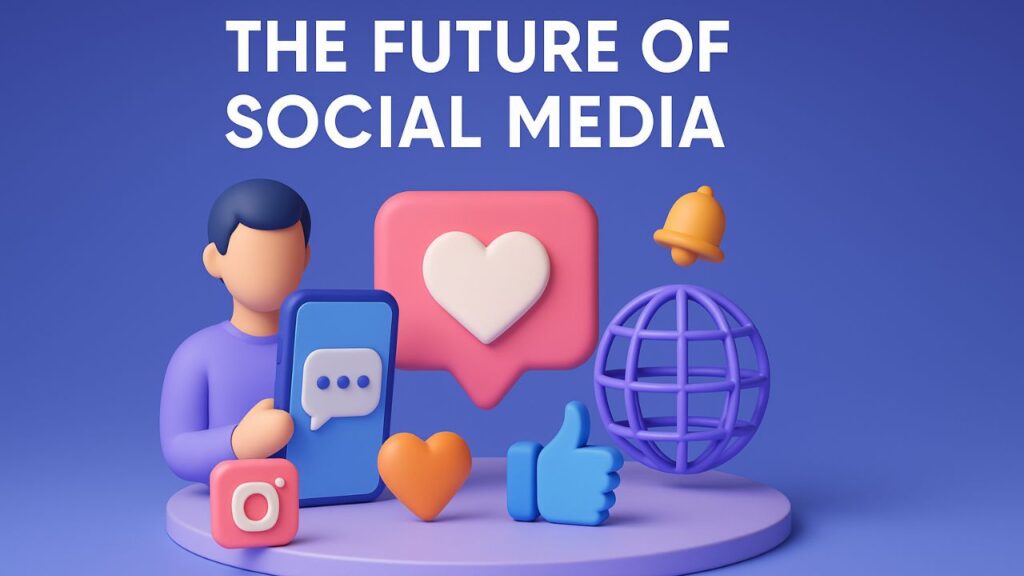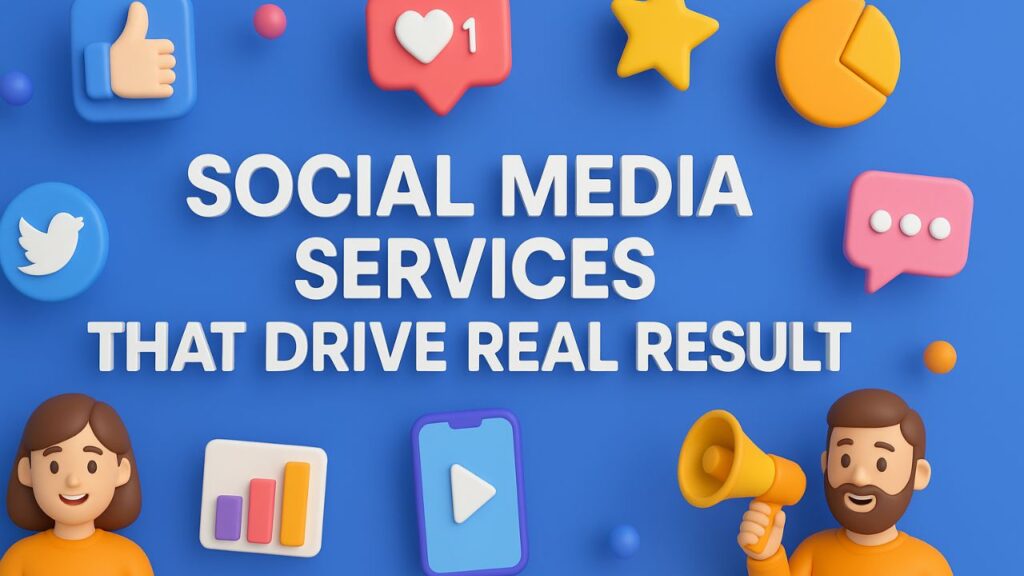In today’s digital landscape, few platforms offer the reach and engagement of social media. As user attention continues to shift from traditional media to mobile screens, the strategic use of social media services has become essential for businesses aiming to build visibility, drive engagement, and deliver measurable outcomes.
This blog explores how social media services contribute to tangible business results. It dissects what these services include, how they align with business goals, and how they can be tailored for consistent and scalable outcomes. Whether you’re just beginning your digital strategy or refining an existing one, understanding the framework behind effective social media efforts can guide your direction
Table of Contents
1. Introduction to Social Media Services
Social media services refer to a suite of strategic, creative, and analytical activities performed to optimize a brand’s presence on social platforms. These services are structured to build visibility, engage audiences, and foster interactions that lead to measurable outcomes, be it brand awareness, website traffic, conversions, or customer loyalty.
Unlike organic participation, professionally executed services operate under well-researched strategies, data-backed actions, and systematic optimization processes. Social media services are now an indispensable part of digital marketing for businesses of all sizes.
2. The Role of Strategy in Social Media Success
One of the most overlooked aspects of social media is the planning that precedes execution. Strategy sets the foundation for everything that follows. Without it, even visually appealing content or frequent posting fails to create sustained impact.
An effective strategy answers key questions:
- Who is the target audience?
- What platforms are most relevant?
- What are the campaign goals?
- What content types support these goals?
- What is the optimal posting schedule?
A structured social media strategy allows every piece of content and every engagement to move the business closer to its objectives. This is where social media services come into play—they ensure each decision is driven by insights, not assumptions.
3. Key Social Media Services That Impact Performance
Professional social media services encompass a wide range of actions that work together to enhance brand visibility, engagement, and conversions. Below are the primary categories of services that drive real results:
3.1 Content Creation and Scheduling
Creating engaging and relevant content is essential. This includes:
- Static graphics
- Short-form videos
- Infographics
- Platform-optimized captions
- Stories and reels
- Live session coordination
Content scheduling tools help ensure that posts go out at optimal times for reach and engagement. Consistency is critical, and automation plays a key role in achieving it.
3.2 Audience Research and Segmentation
Effective engagement starts with knowing who the audience is. Social media services conduct research to define audience demographics, interests, behaviors, and trends. This data supports targeted content creation and ad targeting.
Audience segmentation ensures that messaging is tailored to distinct user groups rather than using a one-size-fits-all approach.
3.3 Community Management
Interaction is as important as broadcasting content. Community management involves:
- Responding to comments and messages
- Engaging with audience posts
- Monitoring brand mentions
- Moderating discussions
Timely and thoughtful responses can build brand trust and customer loyalty.
3.4 Social Listening
This involves monitoring platforms for mentions, feedback, and trends. Social listening helps identify what users are saying about the brand, competitors, or industry. This insight informs campaign adjustments and future strategy.
3.5 Paid Campaign Management
Organic reach is limited on most platforms. Paid campaigns enable targeted reach based on age, location, interests, and more. Services include:
- Budget planning
- Creative development
- A/B testing
- Conversion tracking
- Ongoing optimization
These efforts ensure ads are both efficient and impactful.
3.6 Analytics and Reporting
Tracking performance is crucial for assessing return on investment. Social media services provide detailed reports on:
- Engagement rates
- Follower growth
- Website clicks
- Conversion rates
- Sentiment analysis
Reports often include insights and recommendations for improvement.
4. Channel-Specific Social Media Services
Not all platforms serve the same purpose. Each social media channel has a distinct audience, content style, and algorithm. Professional social media services tailor strategies to each one.
4.1 Facebook
Services focus on building communities, running localized ads, and sharing multimedia content. Facebook Groups and retargeting ads are often utilized.
4.2 Instagram
Visual storytelling is central here. Services involve grid planning, reels creation, influencer outreach, and hashtag strategies.
4.3 X (formerly Twitter)
X thrives on brevity and speed. Social media services for this platform prioritize timely updates, trend participation, and interaction with followers.
4.4 LinkedIn
This is ideal for B2B marketing. Services include thought leadership content, professional community engagement, and recruitment-based campaigns.
4.5 YouTube
As a video-first platform, services here include scripting, production, SEO optimization for videos, playlist curation, and comment moderation.
4.6 Pinterest
Visual discovery is key. Services focus on pin design, keyword-rich descriptions, board organization, and linking pins to product or content pages.
5. Performance Metrics That Matter
Assessing success on social media goes beyond likes and shares. Key performance indicators (KPIs) vary by objective but typically include:
5.1 Engagement Rate
Measures how users interact with content. Includes likes, comments, shares, and saves.
5.2 Reach and Impressions
Reach refers to the number of unique users who saw content. Impressions count how many times it was displayed.
5.3 Click-Through Rate (CTR)
Tracks how many users clicked on a link in a post or ad, indicating interest and potential traffic generation.
5.4 Conversion Rate
Calculates the percentage of users who completed a desired action, such as signing up or making a purchase.
5.5 Follower Growth
While not the sole measure of success, steady follower growth indicates growing interest and reach.
6. Challenges in Executing Social Media Campaigns
While social media offers opportunities, it comes with its challenges:
- Platform algorithm changes can impact reach.
- Content fatigue requires creative diversity.
- Audience expectations evolve rapidly.
- Measurement inconsistencies across platforms can make ROI assessment difficult.
This is where structured social media services become essential—they offer data-driven methods to adapt and overcome these obstacles.
7. Integration with Broader Digital Marketing
Social media does not operate in isolation. For best results, it should be integrated into the broader digital ecosystem. This includes:
- SEO: Social posts can support content visibility in search engines.
- Email Marketing: Social platforms can drive newsletter sign-ups.
- Paid Ads: Social ads can complement PPC and display campaigns.
- CRM Systems: Engagement data can be funneled into customer databases for retargeting or segmentation.
Professional social media services often work in coordination with other marketing departments to ensure unified messaging and campaign synchronization.
8. The Future of Social Media Services

The landscape continues to evolve. Looking forward, expect social media services to incorporate:
8.1 AI-Driven Personalization
Machine learning will help tailor content to individual preferences, improving engagement.
8.2 Augmented and Virtual Reality
AR filters and immersive experiences will become part of user interactions, particularly on visual platforms.
8.3 Voice Search Optimization
As voice usage grows, social content may be optimized for voice discoverability.
8.4 Commerce Integration
Social shopping features will blur the lines between browsing and purchasing, offering new avenues for conversion.
Keeping up with these changes requires a flexible and forward-thinking approach to social media services.
Final Thoughts
Social media services have grown far beyond posting updates or replying to comments. They now encompass a comprehensive approach involving strategy, research, creativity, execution, and analysis. When executed with precision and clarity, these services can deliver measurable and lasting results.
By tailoring efforts to each platform, aligning with business goals, and continuously optimizing through data, businesses can build stronger relationships, increase visibility, and convert followers into loyal customers. In a digital-first world, investing in social media services is not optional—it’s foundational.
Frequently Asked Questions (FAQ)
Q1: What are social media services?
Social media services refer to a suite of activities including content creation, audience engagement, campaign management, paid advertising, and analytics designed to enhance brand presence and generate measurable outcomes on social platforms.
Q2: How do social media services drive real results?
By using targeted strategies, data analysis, and platform-specific content, these services improve engagement, drive website traffic, increase conversions, and support overall business objectives.
Q3: Are paid ads part of social media services?
Yes, paid campaign management is a core aspect. It involves designing, launching, and optimizing ads to reach specific audience segments efficiently and at scale.
Q4: Which platforms benefit most from social media services?
Major platforms like Facebook, Instagram, LinkedIn, X (Twitter), YouTube, and Pinterest all benefit. Each platform requires a tailored approach to maximize impact.
Q5: How do social media services integrate with other marketing efforts?
They work alongside SEO, email marketing, PPC, and CRM systems to provide a unified brand message and improve overall digital performance.
Q6: How is performance measured?
Key metrics include engagement rate, reach, impressions, click-through rate, conversions, and follower growth. These indicators help assess ROI and strategy effectiveness.
Q7: Can social media services help with brand reputation?
Yes. Through community management, social listening, and timely responses, services help shape and maintain a positive brand image.
Q8: How often should content be posted?
The ideal frequency depends on the platform and audience behavior. Professional services use analytics to determine optimal posting schedules.



